Traditional Chinese Medicine Treatment in Melanomas of the Horse: A Clinical Study
Francesco Longo*
Italian Veterinary Acupuncture Clinical Center, Italy
Submission: November 11, 2017; Published: December 11, 2017
*Corresponding author: Francesco Longo, Specialist in Physiopathology of Reproduction, Expert in TCM and Veterinary Acupuncture, Italian Veterinary Acupuncture Society, Italian Veterinary Acupuncture Clinical Center, Italy, Tel: 0039/3471861679; Email: longo.agovet@katamail.com
How to cite this article: Francesco L. Traditional Chinese Medicine Treatment in Melanomas of the Horse: A Clinical Study. J Complement Med Alt Healthcare. 2017; 4(3): 555639. DOI: 10.19080/JCMAH.2017.04.555639.
Abstract
Melanomas occur in horses in which the coat turns grey or white. The perineum and the base of tail are the most common sites of development. Treatment consists in the administration of oral drugs or in surgical excision; both therapies do not assure the stop of aggressive re-growth or metastasis. The Acupuncture treatment was applied to 49 horses and it has been compared to usual therapies and over a period of 16 years. Diagnosis and treatment were conducted according to the criteria of Traditional Chinese Medicine (TCM). Acupuncture therapy consisted of dry needles, hydro acupuncture, electro acupuncture, laser puncture and TCM techniques (moxibustion, Chinese massage, Chinese diet), with good results in restraining the development of neoplasms and in improving the general horse wellbeing. The work shows that Acupuncture is a non-invasive medicine that allows long-time monitoring of the disease and to ensure the quality of life of horses and as a viable alternative to conventional therapies. The work confirms the results of the scientific studies that show the mechanisms of acupuncture anti-cancer effects: inhibition of the metabolism of tumour cells; prevention of metastasis through improvement of the physical and chemical properties of blood.
Keywords: Veterinary acupuncture; Oncology; Melanoma; Horse
Introduction
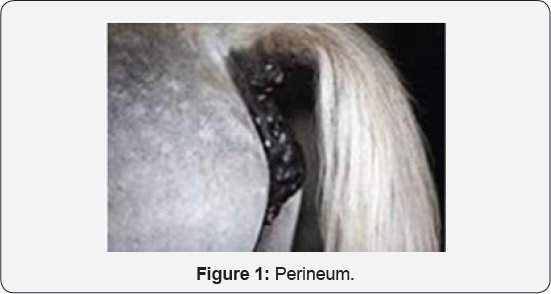
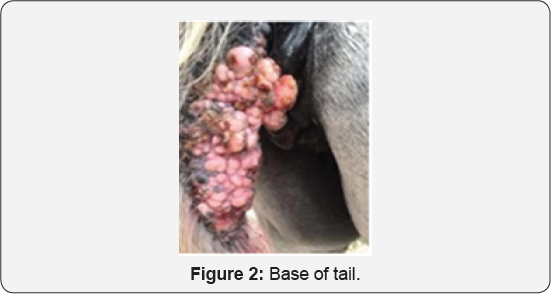
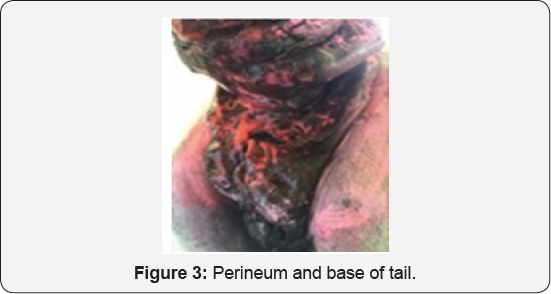
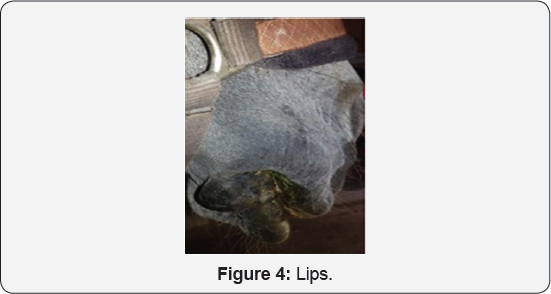

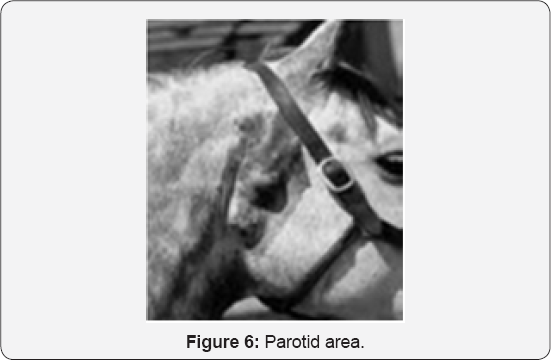
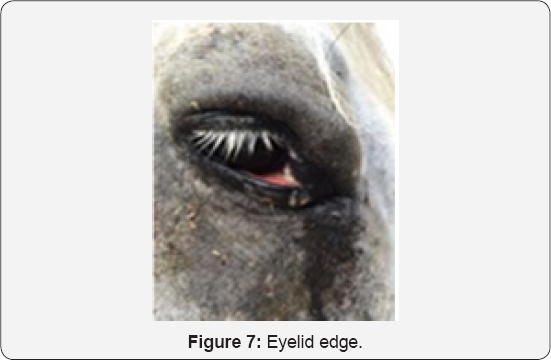
Melanocytic neoplasms occur in horses of over 6 years of age, in horses in which the coat turns grey or white; they are especially common in Lipizzaner, Arabians, Percherons and certain family lines have also been identified to be predisposed to the condition probably as a result of in-breeding. The perineum and the base of tail are the most common sites of development Figure 1-3, but this neoplasia develops in any location: lips Figure 4, neck, mane Figure 5, parotid area Figure 6, eyelid edge Figure 7, shoulders, trunk, lymph node involvement. The tumors are often multiple with pedunculated nodules that they can ulcerate with consequent worsening of the local lesions (bleeding, ulceration, secondary bacterial infection, parasites invasion, colonization by maggots). The pathogenesis is not clear: maybe an actinic damage is involved in development of melanoma. According to Rosengren Pielberg et al. [1] there is an autosomal dominant trait associated with a high incidence of melanoma and vitiligolike depigmentation. The grey phenotype is caused by a 4.6-kb duplication in intron 6 of STX17 (syntaxin-17) that constitutes acis-acting regulatory mutation; both STX17 and the neighboring NR4A3gene are over expressed in melanomas from grey horses. Grey horses carrying a loss-of-function mutation in ASIP (agouti signalling protein) had a higher incidence of melanoma, implying that increased melanocortin-1 receptor signalling promotes melanoma development in grey horses [1].
Western Treatments
Medical treatment consists in the oral drug cimetidine (a histamine H2-receptor antagonist) at the dose of 2.5mg/kg of body weight, PO, q 8h. Cimetidine has shown good results in some horses [2] but in the current therapy it has variable results as well as immunotherapeutic approaches [3]. Surgical excision is the mainstay of treatment and is often accompanied by cryosurgery (freezing); incomplete excision may increase the risk of aggressive re-growth or metastasis. Many scientific studies have attested the validity of Traditional Chinese Medicine (TCM) and TCM. Acupuncture in the treatment of secondary complications of cancer: pain therapy, remission of symptoms, suppression of side effects, stimulation and increase of immune functions of the body, and in the treatment of the complications induced by chemotherapy or radiation therapy [4,5]. There is also another important clinical use of Acupuncture which consists in the approach directed to tumour
In many Chinese classical medical texts are chapters devoted to tumours (such as the Ling Shu, and in Zhenjiu Jiayi Jing of Huangfu Mi). Neoplasia presents with the characters of the diathesis, an intermediate state between healthy and morbid full-blown disease, a general condition of organic dysfunction and
'dis -' regulation of physiological functions. If the body fails to respond to this situation, or if a proper and early treatment does not make at this stage, the morbid state evolves towards stabilization and at the onset of organic lesion [6]. The chronic stress or the perpetuating stress change in heterostasis a situation in which GABA, endorphin, serotonin and other chemical mediators try to mitigate the stress stimuli: this new condition has named habit characterized by chronic stress. The subsequent excessive production in endogenous cortisol determine a damage in hippocampus. The first system that suffers the consequences is the digestive system (gastritis, malabsorption, diarrhoea) and right after is the immune system [7]. In veterinary medicine there are already numerous scientific studies and clinical evidences in the direct treatment of tumours employing Acupuncture, in horse medicine too [8]. According to TCM the prolonged closure of Baihui point (GV 20) determines vitiligo on eyelid margin (that is a prodromal sign in average 85% of the cases). This closure is due to energetic deficit of the Du Mai (Governor Vessel) and of its Luo channel (that starts from perineum at level of Changqiang - GV1). This situation determines an accumulation of Xie Qi (perverse energy) in the perineal area with subsequent growth of the tumour masses in this place [9].
Acupuncture
Therapy was aimed at reducing tumour masses, promote the energy flow along the Du Mai (Governor Vessel), support the body's immune competence, and improve the physiology of the whole organism.
The initial cycle of Acupuncture provides 4-5 sessions with an interval between them of 7-10 days, then it sets a precise local therapy and adequate food, also a specific functional exercises are recommended. Subsequent cycles provide 1-2 sessions per month, with intervals between them of 12 - 15 days, which are considered "maintenance sessions”. In the case of aggravation of the disease it has been possible to intervene with tight seating. For each session specific points have been used to balance the energy of each single horse and make more effective the session aimed at slowing tumour growth.
The acupoints most frequently employed were:
a. Jingming (BL 1): it activates the epiphysis - hypothalamus - pituitary axis for the complete endocrine regulation Figure 8.
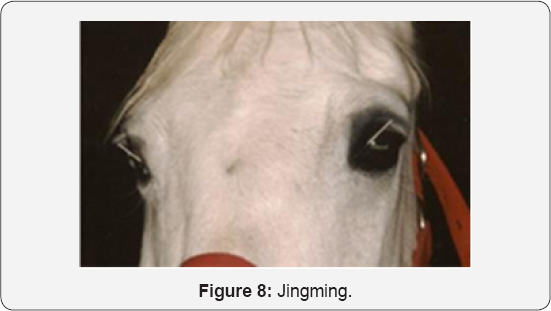
b. Zhiyin (BL 67): it rules Tai Yang level involved with the function of the immune system (Figure 9).
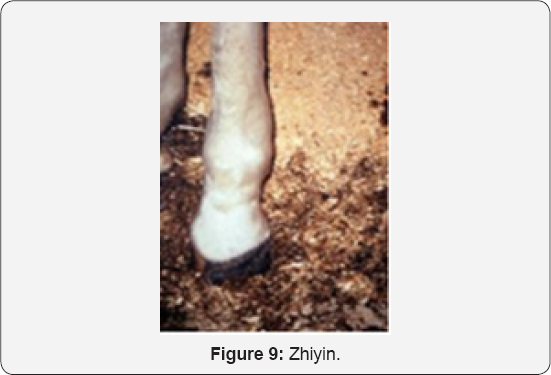
c. Baihui [GV 2G]: it regulates brain functions.
d. Houxi (SI 3): it is cardinal point for Du Mai (Governor Vessel, it allows the energy circulation on this channel).
e. Pishu (BL 20): it treats diseases of the lymphatic system (traditionally it has the function of maintaining organs and tissues within their natural anatomical limits).
f. Zangmen (LR 13): it treats the abdomen chronic diseases (traditionally supports the action of BL 20).
g. Dadun (LR 1): it regulates the blood circulation; traditionally it is considered the main acupoint to slow or stop tumour growth Figure 10.

Depending on the clinical needs, other TCM therapies have been employed:
A. Moxibustion is the thermal stimulation of the acupoints by the use of cones and cigars. It is prepared from herbs, such as Artemisia vulgaris, Artemisia argyi, Artemisia sinensis and others, which are able to burn very slowly, uniformly, developing a considerable amount of heat that is in can stimulate points effectively. The area of skin stimulated by this method shows an intense hyperemia that evokes the following effects: vasodilation and increased blood flow in the deep layers, increased activation or sensitivity of local receptors of the affected tissue ranging from impact needle, involvement of thermal nociceptors innervated by A-5 fibers and polymodal nociceptors.
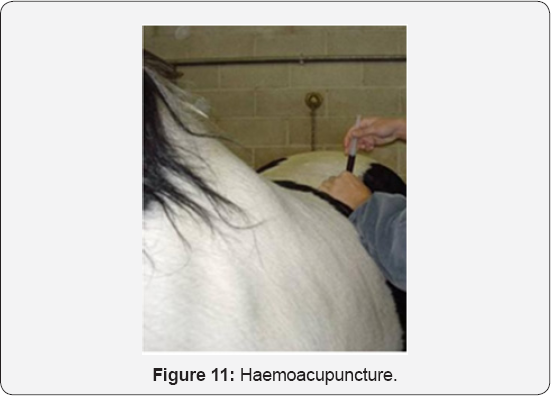
B. Haemoacupuncture in which the blood of the same horse is used as a medium, which picked up, it was immediately inoculated on selected acupoints Figure 11. Hydroacupuncture consist in inoculating small amounts of Vitamin B, or iodine in the oil vehicle, or of physiological solution; it is also possible to use solutions of Chinese herbal extracts (Angelica sinensis, Carthamus tinctorius, Coptis sinensis, Andrographis paniculata). Normally it is used from 1 to 2,5ml of product per point so as to determine a more prolonged stimulation of the same.
C. Electroacupuncture is a complex method that employs the passage of an electric current through the needle until point; the direct current was applied on Du Mai (Governor Vessel) with aim to allows the energy circulation on this channel; the used current can be modulated in its frequency and amplitude [10].
D. Laserpuncture provides by use of laser technology (Light Amplification by Stimulated Emission of Radiated-on). It was demonstrated the ability of the He-Ne (helium-neon laser) at low power to penetrate the skin and stimulate up to 10-15 mm the underlying tissue to the points, producing a cumulative energy effect. The effects of the lasers are: to increase the activity of phagocytes and macrophages, increase the proportion of y-globulins and complement, modify the permeability of cell membranes, activating cellular enzymes, promote thyroid and adrenal activity, facilitate the formation of fibroblasts and collagen, regenerate nerve tissue. More generally it can be said that the laser has antiphlogistic, analgesic, promotes the growth of tissues, and especially is a non-invasive and quick application. The effects induced by the use of Low Level Laser (LLL), documented by more than 300 scientific publications are: vasodilatation with mast cell degranulation, macrophage activation and lysozyme, increase circulation in diseases accompanied by vascular occlusion, improve the capillary microcirculation and increase circulation, reducing hypertension, regeneration of damaged nerves, recovery of nerve function; the LLL also intervene successfully in the treatment of spondylosis, facial paralysis, rheumatic processes, lumbago, degenerative joint conditions, infertility, prostate disease, corneal ulcers; they are also used in orthopedics, dentistry, immunology [11].

E. Tuina is the traditional Chinese massage included in TCM compound. This dynamic therapy allows the body to become more active and healthy, tones or calm the energy flow, makes the body more resistant to the pathogenic strain. Through the proper use of the hands it is possible to enhance the therapeutic act in synergy with the other medical disciplines. The increase of local circulation induces vasodilatation and consequent increase of heat which is able to activate the analgesic components Figure 12.
Local Therapy
Very important is the local therapy with aim to relieve itching and local pain, promote healing of skin lesions under the tail. It is very important to clean the affected area Figure 13.
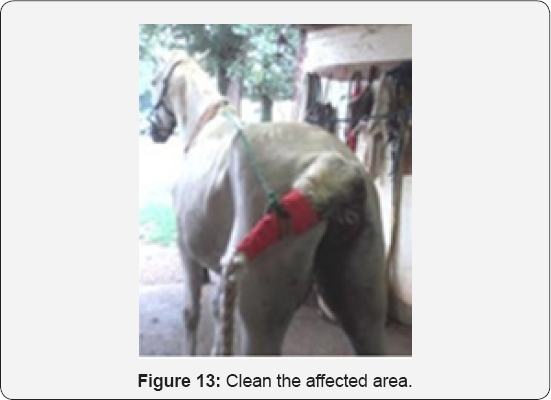
After cleaning, the following products were used:
a. Hypermixvet® RI.MOS. composed of oil of Neem and Hypericum perforatum,
b. Ciderma® Boiron composed of Calendula officinalis (fresh plant).
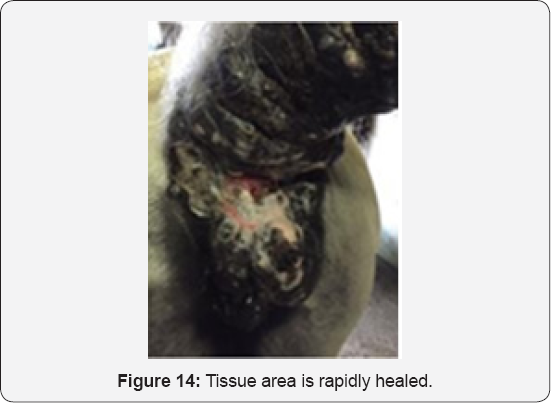
Hypericum perforatum (fresh plant), Achillea millefolium (fresh plant), Ledum palustre (tincture), Anemone pulsatilla (tincture). The components of these two products have antiseptic, antibacterial, antifungal, antiviral, immune stimulant, regenerating and healing action. Wraps of sodium bicarbonate in water are very important: probably the action of it is a pH adjustment at cutaneous level that promotes a clear improvement and reduction of the lesions. In some cases it is proceeded to ligation of pedunculated lesions with normal elastic thread. Within 3-5 days these nodules have fallen without bleeding and the affected tissue area is rapidly healed Figure 14. In 100% of cases treated with this technique, it has been no recurrence in the formation of other peduncles.
Diet
The main aim of feeding is to maintain a constant supply of necessary substances to vital functions and enhances and prolongs the therapeutic effect. For horses suffering from tumours is important the intake of vitamins and oligo-elements present in carrots, fennel, apples. It is very important the assumption of oats: this cereal has a high amount of copper, 429,00mg/100g [12]. Copper intervenes in correcting the following anomalies: impaired collagen synthesis, lax skin, increase glycation of protein, impaired pigment synthesis.
Clinical method
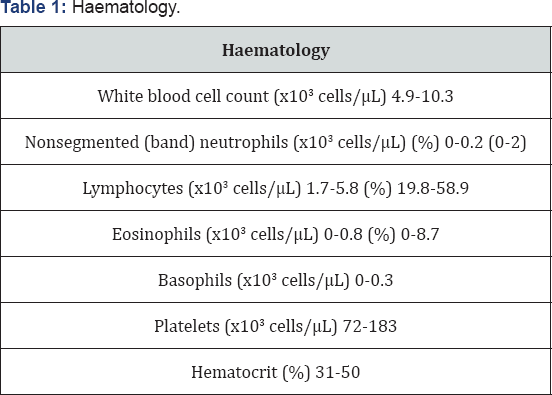
The Acupuncture treatment was applied to 49 horses and it has been compared to usual therapies and over a period of 16 years (1999-2015).Diagnosis and treatment were conducted according to the allopathy and after according to criteria of TCM (energy diagnosis by the criteria of state: conditions of excess or deficiency express trough physical and functional signs). The sessions of Acupuncture lasted about 30 minutes and included some of the therapeutic techniques listed above depending on the contingent requirements of the single horse. After each session, the treated horse was left in the box for at least 30 minutes and not subjected to any exercise or work. The comparative parameters between horse treated by acupuncture and horses treated by usual therapy (allopathy) were: blood profile, size and growth or reduction in tumour masses, possible development of metastases (lymph node involvement), assessment of quality of life by the owners of the horses. The evaluation of blood tests was made on the basis of standard data commonly used at international level and highlighted in Table 1 (haematology) and Table 2 (biochemistry) [13].

Results
a. In the course of tumour disease the most case of the affected horses is a frequent tendency to present normocytic anaemia; 80% of the horses treated with acupuncture presented less levels of anaemia than non-treated horses.
b. In the affected horses there occurs an alteration of the elements of the immune system due to progression of the tumour pathology. The 95% of acupuncture-treated horses show no immune abnormality compared to untreated horses (in which lymphocytopenia was very severe); 5% of the treated horses showed slight decrease in lymphocytes.
c. In the affected horses the tumour nodules grow progressively and diffusive, they may ulcerate, they spread in different locations of the body. In the 100% treated horses occurs a reduction of the volume of the nodules, a tendency to compact, a smaller spread in other locations.
d. The most frequent metastases seems to be at pulmonary and pleural level with involvement of the lymph nodes. It occurred in 35% of untreated horses and 2% of the horses treated with acupuncture.
Respiratory symptoms are tachypnoea (30 breaths/min) and increased respiratory effort; mucous membranes are pink or purple, slightly tacky and capillary refill time was 3 seconds; auscultation generally reveals bilaterally increased lung sounds in the dorsal lung fields and reduced vesicular sounds bilaterally in the ventral lung fields. The fine needle aspirate smears revealed melanocytes with multiple cytological criteria of malignancy including variable pigmentation, multinucleation, moderate-to-marked anisocytosis and anisokaryosis. At post mortem examination large multifocal to coalescing black firm nodular masses were observed in pleura, mediastinum, intercostal spaces and diaphragmatic surface. Very often masses were present in the guttural pouches. The horses treated with acupuncture who presented pulmonary metastases have been treated with specific sessions to slow the metastatic process and counter the symptoms using the diagnostic criteria of Pneumology of allopathic medicine and of TCM.
Most of the horses with melanoma are normally kept in boxes or in paddocks, but do not perform any activity and have bad feeding with inadequate quantity; their condition implies the onset of other diseases that can lead to death of the animals. All of the horses treated with acupuncture lead normal life, can take walks and treks, thereby preventing other diseases.
Discussion
The work confirms the mechanism of Acupuncture anticancer effect: inhibition of the metabolism of tumour cells, prevention of metastasis, improvement of the physical and chemical properties of blood, treatment of the secondary complications of the tumour, direct clinical approach to cancer.
Conclusion
Acupuncture is non-invasive medicine that allows long time monitoring of the disease, it ensures and improves the quality of life of the horses, it is a viable alternative to conventional medicine in treating melanomas.
References
- Rosengren Pielberg G, Golovko A, Sundström E, Curik I, Lennartsson J, et al. (2008) A cis-acting regulatory mutation causes premature hair graying and susceptibility to melanoma in the horse. Nature Genetics 40: 1004-1009.
- Goetz TE, Ogilvie GK, Keegan KG, Johnson PJ (1990) Cimetidine for treatment of melanomas in three horses. J Am Med Assoc 196(3): 449452.
- Metcalfe LVA, O'Brien PJ, Papakonstantinou S, Cahalan SD, McAllister H, et al. (2013) Malignant melanoma in a grey horse: case presentation and review of equine melanoma treatment options. Irish Veterinary Journal 66(1): 22.
- Lin JG, Chen YH (2012) The Role of Acupuncture in Cancer Supportive Care Am J Chin Med 40(2): 219-229.
- Sagar SM (2008) Acupuncture as an Evidence-Based Option for Symptom Control in Cancer Patients. Curr Treat Options Oncol 9(2-3): 117-126.
- Longo F (2007) TCM in Oncology. Proceedings of 56th S C I V Congress, Japan, pp. 230- 232.
- Longo F (2010) Engrams and Synchronicity: Acupuncture Treatment in Chronic, Rebel and Recurrent Diseases. Proceedings of Veterinary Acupuncturists of Mediterranean Congress, Paris, France.
- Thoresen AS (2011) Outcome of horses with sarcoids treated with acupuncture at a single ting point: 18 cases (1995-2009). American Journal of Traditional Chinese Veterinary Medicine 6(2): 29-35.
- Longo F (2016) TCM Treatment in Melanomas of the Horse. Proceedings of the ECIM Congress, Slovenia, pp. 9-11.
- Longo F, Gazzola M (2012) Scientific basis of veterinary acupuncture proceedings of the 15th world congress on medical acupuncture. ICMART, Greece.
- Longo F (2007) Traditional Chinese Veterinary Medicine. In: Pignatelli P (Ed.), Medicina Veterinaria Non Convenzionale. Edagricole, Italy, pp. 135-137.
- Longo F (2005) The main food diseases in horse: Diagnosis and therapy in TCM; in diagnostic-therapeutic paths in diet-related diseases in veterinary medicine. Proceedings of Holistic Nutrition Congress, Capaccio Paestum, Italy, pp. 35-43.
- Southwood LL (2013): Normal ranges for haematology and plasma chemistry and conversion table for units. Wiley Online Library, pp. 339-342.






























